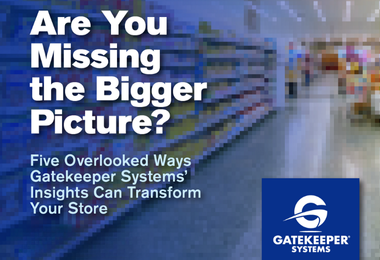Robert Harling, CEO of Gatekeeper Systems, highlighted the Purchek® Pushout Theft Prevention Solution in his article on Retail Touch Points. He addressed the growing challenge of pushout theft, where shoplifters use shopping carts to steal large quantities of merchandise. This form of theft significantly impacts retailers, leading to financial losses, increased operational costs, and safety concerns for employees and customers.
Harling detailed various strategies that retailers are employing to combat this issue, such as locking high-value items, verifying receipts at store exits, and using wheel-locking technology. Purchek® is one such innovative solution that disables cart wheels when unpaid merchandise attempts to leave the store, effectively deterring theft without confrontations. Harling emphasized the importance of integrating such technologies to maintain a secure shopping environment while leveraging advancements like artificial intelligence to enhance theft prevention and customer experience.
Here is the full article:
In the retail world, a unique type of theft has been steadily increasing: pushout theft. This phenomenon, where shoplifters brazenly wheel out carts laden with unpaid merchandise, is causing significant financial strain on retailers. As this form of theft becomes increasingly sophisticated, the industry is scrambling to find effective solutions.
Rising Rate of Pushout Theft
The heightened awareness of pushout theft is not just anecdotal; it’s supported by data showing an uptick in organized retail crime (ORC). The National Retail Federation (NRF) reported a 19.3% increase in retail shrink, attributing a significant portion of this loss to external theft. Retailers across the globe have cited theft as a primary reason for closing stores, underscoring the severity of the issue. It’s a growing problem within all cart-based retail stores due to rising product prices, ease of resale and increased levels of felony threshold.
Using a cart, shoplifters can steal up to 50X more goods than carryout theft incidents, with total cart worth ranging from nominal amounts to staggering figures exceeding $12,000 per incident.
The consequences of pushout theft extend beyond mere inventory loss. Retailers face increased operational costs, including higher insurance premiums and the need to raise prices, which can alienate customers. Moreover, the nature of these thefts and their increasing violence pose a direct threat to the safety and well-being of store employees and customers. This creates a pressing need for retailers to address theft to protect profits and maintain a safe shopping environment.
Retailers’ Responses to Combat Theft
Retailers of all sizes are implementing a variety of innovative strategies to safeguard their merchandise while striving to maintain a friction-free shopping experience for customers.
One prevalent approach involves locking up high-value or highly sought-after items like cosmetics. This measure necessitates staff intervention for customer access, thus significantly reducing the likelihood of theft. However, this method can occasionally inconvenience shoppers needing assistance examining or purchasing products.
Another tactic is the verification of receipts at store exits, ensuring that the items leaving the store have been properly paid for. While effective in curbing theft, some customers might perceive this practice as an implication of mistrust, and it puts workers at increased risk.
Furthermore, adjusting the store layout to ensure all exits pass through checkout areas has been adopted by several retailers as a subtle yet effective way to deter theft. This design change minimizes the opportunities for shoplifters to exit the store unnoticed with unpaid merchandise. Additionally, technological solutions like at-the-door alarms are used to alert loss prevention officers and deter the thief, but ultimately they don’t stop anyone from exiting the store.
Wheel-locking technology for shopping carts is becoming increasingly popular. These systems are designed to trigger when unpaid merchandise attempts to leave the store, disabling the wheels and setting off an alarm regardless of who is pushing the cart and what items are within it.
This non-confrontational method acts as a first line of defense, allowing security officers to assess the situation before engaging. In most cases, shoplifters walk away from the cart, leaving the merchandise in the store. It not only deters potential thieves but also serves as a reminder of the store’s vigilance against theft, contributing to the overall security of the shopping environment.
By integrating these strategies, retailers are addressing the immediate challenge of pushout theft and reinforcing their commitment to creating a secure and welcoming environment for all customers.
Future of Theft Prevention: The Role of AI
Advancements in technology, particularly in artificial intelligence, offer new avenues for preventing retail theft. AI can analyze vast amounts of data to identify suspicious shopping cart patterns, potentially stopping theft before it occurs. It also can enhance customer service by freeing staff to focus on service rather than surveillance, thus maintaining the delicate balance between security and a positive shopping experience.
As retail theft evolves, so too must the strategies to combat it. The future of theft prevention in retail will likely see a blend of traditional security measures and innovative technologies like AI. Retailers must balance the need for security with the imperative of providing a positive shopping environment that’s safe for workers and customers. The challenge lies not just in stopping theft but in doing so in a way that upholds the values of the retail brand and ensures its customers’ and employees’ loyalty and safety.
Robert Harling brings over 20 years of experience driving innovation and growth in the retail loss prevention industry. As CEO of Gatekeeper Systems, a leading provider of tech-enabled loss prevention solutions, he oversees technology development and business strategy, directing the company’s mission to protect retail associates and keep retail merchandise and assets secure while enhancing profits for retailers. Prior to joining Gatekeeper Systems, Harling served as CEO of Carttronics, where he helped establish the market for pushout theft solutions. In 2017, Carttronics was acquired by Gatekeeper Systems and in 2018 Harling was named CEO of the newly combined company.
You can read the full article directly on Retail Touch Points here




